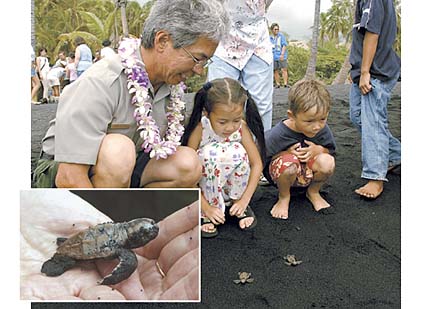
ASSOCIATED PRESS PHOTOS
Ecologist Larry Katahira, left, and two youngsters watched as a pair of healthy Hawaiian hawksbill hatchlings crawled from their nest toward the gently lapping waves Monday afternoon in Punaluu, Hawaii. One of the last apparently healthy turtles recovered from the nest and set free at the water's edge.
Rare turtles
hatch on
Big IslandMore than 100 endangered
hawksbill turtles hatch at
Punaluu’s black sand beach
PUNALUU, Hawaii -- More than 100 endangered baby sea turtles hatched last weekend from a nest on Punaluu's black sand beach, where a female Hawaiian hawksbill turtle known by the tag "60M" laid her eggs in July.
It was the first time one of the rare sea turtles has nested along the popular narrow beach since 1999.
Although the black sand beach is known for its Hawaiian green sea turtles, those turtles prefer to swim the hundreds of miles to French Frigate Shoals in the Northwest Hawaiian Islands to nest.
The Hawaiian hawksbill will nest every two to five years, mostly on remote beaches in Kau and Puna on the Big Island. A few nest on Maui and Molokai.
The 2003 nesting season has been relatively slow, with only six turtles observed nesting along Big Island beaches to date, said Larry Katahira, a resource management specialist at Hawaii Volcanoes National Park.
Each hawksbill turtle can lay up to six nests during the nesting season, which runs from June to November. The six turtles observed this year established a total of 19 nests at four locations, including four nests at an area south of Punaluu Beach being called "Halfway" because it is midway between Punaluu and Ninole to the south.
Halfway is a small pocket of sand where turtles were known to have nested historically but not in recent years.
The turtle that nested July 9 and left 184 eggs at Punaluu was first tagged by volunteers from the national park's turtle program in 1996 when she nested at Kamehame, a beach north of Punaluu that recently has become the most common nesting site for hawksbills.
But she had not been seen since.
It is unknown if the turtle failed to nest during that time or instead nested undetected at a remote beach, Katahira said.
"We don't know where she's gone," he said. "Usually they will come back to the same area. It could be that she nested somewhere unknown to us."
Hawksbills are known for nesting in small pockets of coastal sand, such as at Halfway where nests easily could be missed, he said.
Although turtle 60M made several repeat visits to Punaluu after the July 9 nesting, she only dug holes and left no eggs.
The July 9 nest was discovered by Savannah Silva, a junior at Kau High School who was among a group of students led by science teacher Renwick Bibilone returning from an overnight stay at Kamehame with park field biologist Eldridge Naboa.
"The kids were really excited," Bibilone said.
Last Saturday, 90 hatchlings dug their way out of the nest, which had been fenced off for protection, and headed for the ocean. Two more emerged Sunday.
On Monday, Silva was there to assist biologists with helping the final 25 hatchlings find their way to the water.
"She just jumped at the opportunity," Bibilone said.
One of the six nesting turtles this year was newly tagged, at Halape in Hawaii Volcanoes National Park.
Hawksbill sea turtles are also found in the Atlantic and Indian oceans and in the Caribbean. They were placed on the federal Endangered Species list in 1970.
